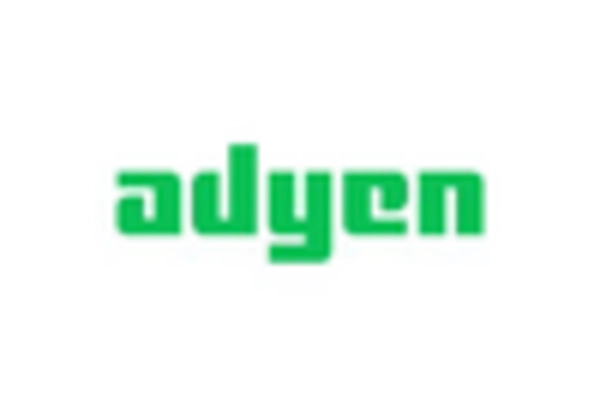The Embedded Banking Service Market is currently characterized by a dynamic competitive landscape, driven by rapid technological advancements and evolving consumer expectations. Key players such as Stripe (US), PayPal (US), and Revolut (GB) are at the forefront, each adopting distinct strategies to enhance their market positioning. Stripe (US) focuses on innovation through its robust API offerings, enabling businesses to integrate payment solutions seamlessly. PayPal (US), on the other hand, emphasizes strategic partnerships and acquisitions to expand its service portfolio, thereby enhancing customer engagement. Revolut (GB) is leveraging its digital-first approach to attract a younger demographic, positioning itself as a comprehensive financial platform. Collectively, these strategies contribute to a competitive environment that is increasingly centered around customer-centric solutions and technological integration.
The business tactics employed by these companies reflect a nuanced understanding of market demands. For instance, localizing services to cater to regional preferences and optimizing supply chains for efficiency are prevalent strategies. The market appears moderately fragmented, with several players vying for dominance, yet the influence of major companies is substantial. Their collective actions shape the market structure, fostering an environment where innovation and customer experience are paramount.
In August 2025, Stripe (US) announced the launch of its new embedded finance platform, which allows businesses to offer banking services directly within their applications. This strategic move is significant as it not only enhances Stripe's service offerings but also positions it as a key player in the embedded banking space, potentially attracting a broader range of clients seeking integrated financial solutions. The implications of this development suggest a shift towards more comprehensive service ecosystems in the financial technology sector.
In September 2025, PayPal (US) completed its acquisition of a leading digital wallet provider, enhancing its capabilities in the embedded banking domain. This acquisition is pivotal as it allows PayPal to integrate advanced payment functionalities into its existing platform, thereby improving user experience and expanding its market reach. Such strategic actions indicate a trend towards consolidation in the market, where companies seek to bolster their technological capabilities through mergers and acquisitions.
In July 2025, Revolut (GB) launched a new feature that enables users to earn interest on their savings directly within the app, reflecting a growing trend towards personalized banking experiences. This initiative not only enhances customer loyalty but also positions Revolut as a forward-thinking player in the embedded banking market. The strategic importance of this move lies in its potential to attract users who prioritize financial growth and innovation in their banking experiences.
As of October 2025, the competitive trends in the Embedded Banking Service Market are increasingly defined by digitalization, sustainability, and the integration of artificial intelligence. Strategic alliances among key players are shaping the landscape, fostering innovation and enhancing service delivery. Looking ahead, it appears that competitive differentiation will evolve, with a pronounced shift from price-based competition to a focus on technological innovation, customer experience, and supply chain reliability. This evolution suggests that companies must continuously adapt to maintain their competitive edge in an ever-changing market.

















Leave a Comment